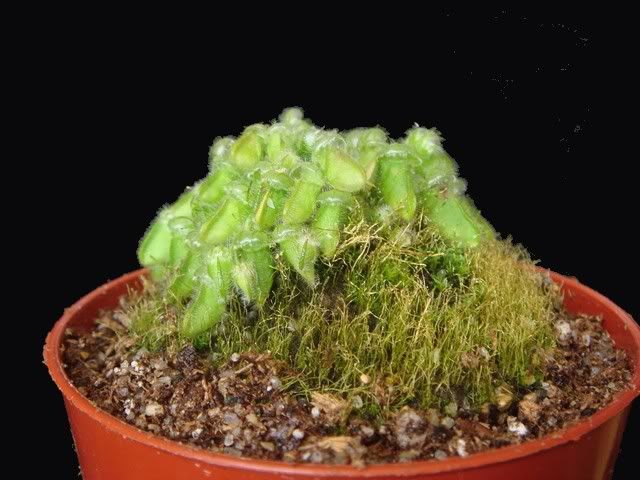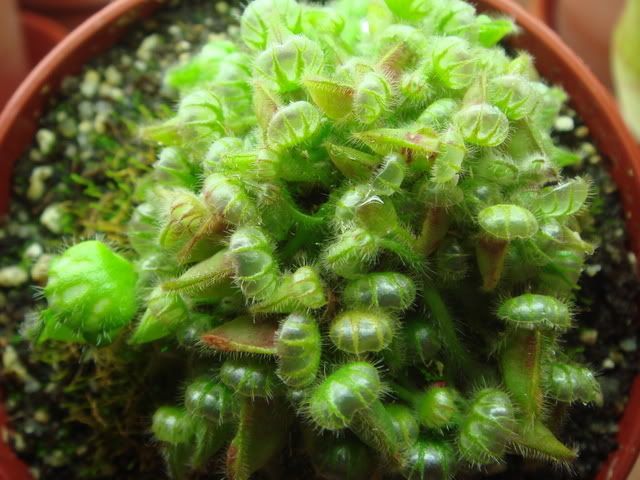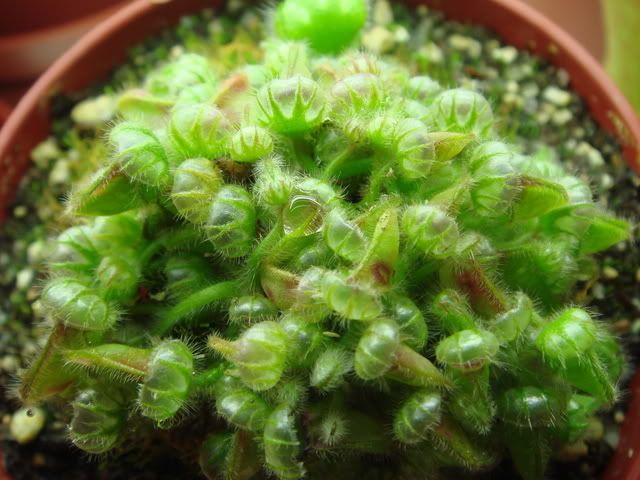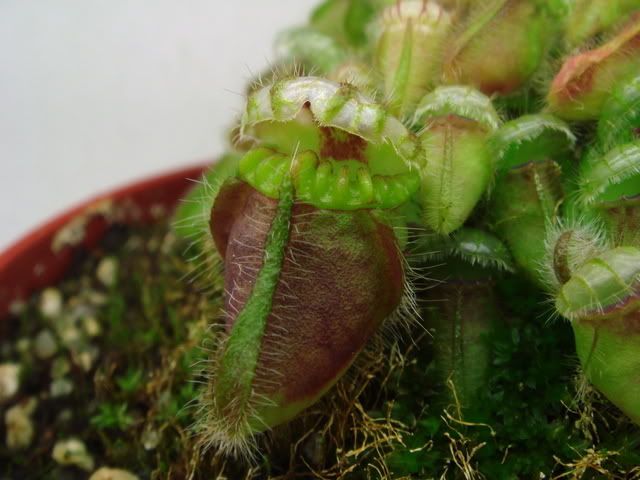|
|
Post by cindy on Jan 18, 2008 10:49:00 GMT 8
It was repotted in November and looked like this.  Two months later, it seems very happy with the change. ;D   |
|
|
|
Post by tarence on Jan 18, 2008 11:19:09 GMT 8
Must learn some deep breathing exercises......aiyo, so pretty & cute the clump of ceph pitchers. most if not all of us here are struggling with cephs ( those who own cephs but just keep quiet dunno lah ) so pics like this are an inspiration to me.
|
|
|
|
Post by agustinfranco on Jan 18, 2008 17:17:30 GMT 8
Dear Cindy: Your intuition to grow these babies will help many more growers as cephalotus is not an easy plant to find. Thanks for your sharing your knowledge.  Gus |
|
|
|
Post by lisham on Jan 18, 2008 19:40:57 GMT 8
Starting from now... I'll practise extra-caution when clicking on any posting by Cindy.... hehehhe....
|
|
|
|
Post by cindy on Jan 18, 2008 20:42:10 GMT 8
Lisham, how much caution was that when you clicked on this post?  Top views ;D   |
|
|
|
Post by ameliepoulain on Jan 19, 2008 8:14:31 GMT 8
my eyes! my eyes!  DARN! you got me  |
|
|
|
Post by lisham on Jan 19, 2008 8:40:03 GMT 8
Lisham, how much caution was that when you clicked on this post?  I accidentally clicked! Anyway... When I'm tempted by the pix of your posting... I'll remind myself on the pix in tarences' posting about his 6 cephs... The remedy.... |
|
|
|
Post by cindy on Jan 19, 2008 16:21:07 GMT 8
Lisham, That remedy only works for a while. A couple of years ago, I was worse than Tarence, killing every Ceph I bought. Now at least I have a few plants to show.  |
|
|
|
Post by tarence on Jan 21, 2008 12:41:28 GMT 8
i think tiny but hundreds of ceph pitchers also hold their own fascinating qualities as opposed to large but few pitchets. Very the gorgeous.
cindy : wei, worse than Tarence ? heheh....compliment or what ?
|
|
|
|
Post by jonathan on Jan 21, 2008 13:33:16 GMT 8
Hi cindy... The Albany pitcher plant is really the crown jewels of carnivorous plant world but this plant is still relatively rare in cultivation for carnivorous plant collectors in malaysia... A well-grown Cephalotus with multiple pitchers is a sight to behold and cindy's Cephalotus picture is surely something we will be looking forward for... ;D Cindy thank you very much for sharing all those beautiful Cephalotus picture  Regards Jonathan |
|
|
|
Post by cindy on Jan 23, 2008 9:35:21 GMT 8
Jonathan, The plant is rare because of its renowned difficulty. But in Singapore, we got a chance to buy them in bulk when Phill Mann of Southern Carnivores came over in December last year. I think we might have the largest number of Cephs now in collection than the whole of SE Asia itself! LOL This plant is still expensive because of the shipping and phyto certs. The plant itself is not that costly. But the demand is still there so I am bringing in more of them this month.  But hopefully as more and more growers have experiences with them, this species will be considered from difficult to moderately easy to grow. In my experience, it is true that once established, all it needs is sunlight and watering.  |
|
|
|
Post by jonathan on Jan 23, 2008 12:52:19 GMT 8
Yeah i agree with you cindy... singapore really does have the larges collection of cephalotus as far as i know...
I have read a whole bunch of web site about cephalotus and most of them consider them easy after they are established, it's also have problem with shipment shock and the new invoirement plus people without experience that does wrong handling lead them to sudden death....
Hopefully one day i'll be experience enough to take care of those baby...
Thank you cindy for the explanation... wish to know more of them....
Regards Jonathan
|
|
|
|
Post by cindy on Jan 23, 2008 18:33:56 GMT 8
Hi Jonathan, I am now establishing some Cephs so that the next batch for sale will be the hardened ones in pots.  Actually, they were the runts of the lot which Phill brought over for sale. He packed them a little too wet so all the pitchers and leaves turned black, making them not suitable for sale. Phill freaked all of us out by plucking off nearly all the green parts!  I brought the little ginger bits home and potted them up. It is an excellent experience because they are rather like rhizome cuttings. Now they have started growing and some even produced pitchers. Considering that they were potted up around 15th December last year, these rhizomes are doing very well. Hopefully, they would be ready by the end of February. I already have people who wants to pre-book these plants. But I don't dare to promise anyone yet because I still need to repot them and that in itself is another challenge.  |
|
|
|
Post by jonathan on Jan 23, 2008 23:04:36 GMT 8
Hi Cindy,
I read if the rhizome is matured enough it will revive and most of the ceph that die off after shipment is because of the same reason...when people ship a young ceph in a package where the humidity is hight and when they reach the destination the owner expose them to lower humidity for hardening process all the leaves turn black eventually the rhizome will turn black together with it and the young ceph dies off...
But in other case when you send out an older ceph all that dies off is only the leaves and pitcher and eventually the rhizome will still make it... then within month you will see new growth and this is also a ceph that don't need to go trough hardening process they will adapt to the current condition they are in...
Cindy, from your experience in handling cephalotus do you think it's true? i'm really happy that we have this discussion and it help me understand this baby batter... thank you very much cindy...
Regards Jonathan
|
|
|
|
Post by cindy on Jan 24, 2008 13:55:47 GMT 8
Hi Jonathan, I have learnt from Cephs gurus that small cephs generally ship better. I tend to agree, given the number of cephs I potted last month. Small cephs come back faster and are less prone to rot and, they lose less leaves and pitchers compared to large cephs. But like you said, large cephs have larger rhizomes. So when they come back after a while, although slower, they will produce large pitchers more readily. I read somewhere that how you plant the rhizome makes a difference to the type of plant you get. Plant it horizontally and you get multiple growth points and smaller pitchers. Vertically and you get larger pitchers on the few growth points. I didn't try it out so I am not sure. All of the bits I got last were planted vertically because that took up less space in a pot.  Cephs, I noticed, react rather differently when they are placed in lower humidity. They tend to lose their leaves and pitchers very quickly rather than becoming limp like the leaves of Neps. The species tends to withdraw water and nutrients from the existing leaves and pitchers, turning them yellow. So the best thing you can do to save them is to top them up with water and keep the media well-watered. I was told to remove about 50% of the oldest growth on a bareroot plant before potting it up. It helps to minimise water loss and the recover time for the plant is faster. It was hard to do because imagine, you have this new plant with many pitchers and you need to cut them off! But I have done it and the pot can be left without being bagged up. I don't think low humidity is an issue unless we are talking about RH 10-20%. Cindy |
|
|
|
Post by jonathan on Jan 25, 2008 0:32:00 GMT 8
Hi Cindy...
Thank you very much for the info...It's always good to learn from those with experience then to read and guess... hehe...
Cindy, if i have more question may i pm you or post in this tread in the future?
Regards Jonathan
|
|
|
|
Post by cindy on Jan 25, 2008 8:43:16 GMT 8
Hi Jonathan, I am still learning myself so please post in this thread so that the actual gurus can help me out.  |
|
|
|
Post by jonathan on Jan 26, 2008 2:52:56 GMT 8
Cindy...
Thanks.. then we can learn together....
Regards Jonathan
|
|
|
|
Post by cindy on Jan 26, 2008 22:49:18 GMT 8
Here is what became of that large pitcher... ;D   |
|
|
|
Post by tarence on Jan 31, 2008 12:19:57 GMT 8
Cindy : hope you`ll get more pitchers of similiar size. it`s easily 5 times larger than the rest yah ?
|
|